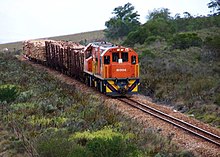
In the early 1900s, 2 ft (610 mm) narrow-gauge railway lines started playing a significant role in South Africa. They facilitated the transport of various agricultural and mineral produce from locations hardly accessible by road. They therefore enabled many communities to become prosperous.
These lines featured the largest and most powerful locomotives ever in existence on two-foot-gauge railways worldwide.
All two-foot railways were operated isolated from each other. However, this did not prevent standardization and interchangeability of rolling stock and locomotives.
The larger railway lines operated their own workshops performing minor to major maintenance and/or repairs. For the purpose of major overhauls and interchangeability, rolling stock could be transported piggyback on Cape gauge rolling stock by means of a special access ramp on the break of gauge at Cape gauge junctions available on most of the two-foot lines.
Their decline started in the 1980s, the last commercial line ceased operations in the 1990s. Only a few tourist, agricultural and/or heritage railways survive. Many defunct locomotives are plinthed at various former railway station sites or work on the Welsh Highland Railway and other heritage railways in and outside South Africa.